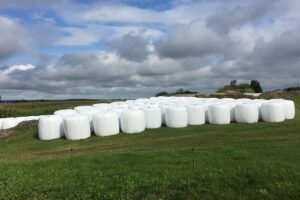Five decades ago, when Barry Friesen worked his first job on a dairy farm, plastic products were scarce. Today, efforts are underway to address the proliferation of plastics now routinely used in modern agriculture processes.

Prior to having plastics available, tasks like gathering hay were cumbersome.
“It took the team six weeks to complete what can now be done by one person in three days,” Mr. Friesen recalls. “Plastics – combined with technology – had a phenomenal impact on the agriculture industry, resulting in much more efficient ways of growing and delivering food.”
Yet in the interim, plastics have been identified as a major global problem, causing pollution that affects both terrestrial and aquatic ecosystems. In answer to the challenge of retaining positive gains from using plastics without detrimental environmental impact, Mr. Friesen advocates for moving towards a circular economy model.
“If we want to keep these useful plastics in the economy,” he says, “we have to provide farmers with the tools for recycling agricultural plastics products.”
Canadian farmers are busy growing food while having to contend with factors like unpredictable weather, supply chain disruptions and labour force challenges.
They also place a high value on sustainability, says Mr. Friesen, executive director at Cleanfarms, a non-profit environmental stewardship organization offering recycling and recovery solutions in collaboration with members, partner agencies and governments.
“Farmers want to do the right thing. They want to leave their farm in as good or an even better condition for coming generations,” he says. “But solutions have to make sense for them – and have to address the entire value chain.”
In Canada, a minimum of 62,000 tonnes of plastic are generated annually for the agriculture industry, according to Cleanfarms estimates.
“Picture 2,800 fully loaded 53-foot transfer trailers,” says Mr. Friesen. “We currently collect about 10 per cent of this volume through our programs.”
Cleanfarms’ comprehensive collection programs have grown over the years due to “overwhelming demand,” he explains.
“The vast majority of what we manage is related to plastics, but we also deal with fibre-based materials and have a disposal program for pesticide and animal health product remainders.”
The agricultural container recycling program, which started in 1989 – and has been operated for more than a decade by Cleanfarms – now achieves “almost 80 per cent recovery,” he says.
“That’s a very high level, but we know we can do even better. Brazil, for example, has a 94 per cent recovery rate.”
Kim Timmer, Cleanfarms’ director for stakeholder relations and policy, is happy to report that “these empty containers go into making drainage tile that is often used on farms, particularly in Eastern Canada.”
That’s where the expertise in recycling and markets from Cleanfarms’ teams can help inspire confidence among farmers and members alike. “Farmers want proof that the extra work is worth the effort,” she says.
“And our members – from large brands that operate on an international scale down to small local retailers – are taking this very seriously. They’re financing these programs, and their goal is to provide programs that deliver results.”
Strong connections to the agriculture community are essential to ensure success.
“By listening to farmers – and making our programs as convenient as possible – that’s how we get these products returned,” says Ms. Timmer.
“Farmers are also actively engaged in finding innovative ways to make recycling more efficient. One of our programs is for bale wrap, and there’s a farmer in eastern Ontario who invented a cost-effective compactor for compressing this material to make transporting it easier.”
Numbers confirm an enthusiastic uptake of Cleanfarms’ endeavours: when the grain bag recycling program kicked off in Saskatchewan in 2018, it brought in 1,200 tonnes that year. In 2021, over 2,400 tonnes of grain bags were returned, says Ms. Timmer.
“When we offer convenient and cost-effective programs, farmers will overwhelmingly use them over other disposal methods.”
A steady expansion has enabled the recovery of more and more products, including “agricultural film products – such as grain bags and bale wrap – and twine, which are now being regulated in some Canadian provinces,” says Mr. Friesen, adding that regulation can help accelerate the adoption of recycling practices.
“Provinces can require that programs are in place to take back the products sold in their jurisdiction. That’s what we’re managing in Saskatchewan, Manitoba, Quebec and PEI, which have such regulations in place.”
Cleanfarms is also running pilot programs, supported through federal funding, in Ontario and B.C., and in co-operation with other stakeholder groups “to prepare for when agricultural plastics recycling becomes mandatory for ag industries across the country. We need a level playing field where everybody can play a role,” says Mr. Friesen.
“We deal with a lot of complexity, including geographical and cultural differences – and different levels of adoption of recycling and composting practices, and that’s why we collaborate with colleagues across the country and around the world.”
Despite regional differences, the old adage “a rising tide lifts all boats” can be applied, he notes.
“When we have a strong recycling culture, we recycle more products, which will help to build more capacity in the manufacturing industry to turn these materials into products as part of a circular economy.”
By building strong relationships with farmers, brand owners, distributors, retailers, advocacy groups and all levels of government, Mr. Friesen sees Cleanfarms’ “full value chain engagement” as a powerful catalyst for moving forward.
More information at cleanfarms.ca.
~Randall Anthony~
Globe and Mail (Next Generation Farming Report)
